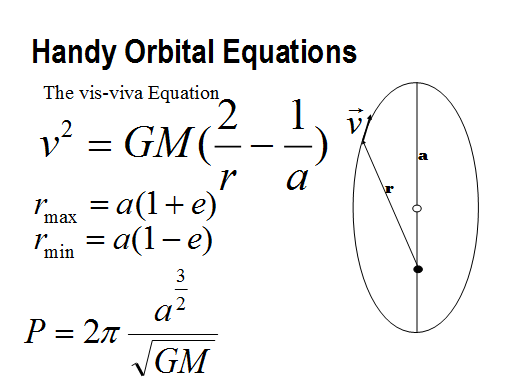
NOTES:
These are some of the handiest equations for dealing with orbital mechanics in a science fictional environment. The orbital energy conservation equation (also called the vis-viva equation) is the total velocity squared of an object at any point in its orbit is equal to a constant times the difference between twice the reciprocal of the current distance from the primary and the reciprocal of the average distance from the primary. What this gives you (among other things) is the delta-v for transfer orbits. If you want to travel from earth to Mars, simply calculate the current orbital velocity of earth, and then the orbital velocity of an object currently at earth's radius but with a maximum distance that just reaches Mars' orbit. That gives you the dV to apply. Once you reach Mars the same equation gives the delta-velocity (delta-V) that will put the spacecraft in the same orbit as Mars.
What makes this equation particularly useful is that you can pick your units for your convenience. When I was taking courses I used units of astronomical units for r and a, and units of miles per second for velocity whenever possible, so that for calculations in the solar system I could determine GM by taking the earth case - all I needed to remember was the length of the year and the size of earth's orbit and I could determine the earth's orbital velocity, and since the distance term in my units was (2-1), GM was easy to solve for and easy to use for any subsequent solar system problem without the pain of memorizing G or M.
The applications to SF for these equations are pretty obvious, but one thing I'd like to highlight is that at any point in an orbit, increasing velocity increases your orbit's semi-major axis, and decreasing velocity decreases it. The trick is that for any given orbit, a nearby orbit with a larger semi-major axis will have a smaller velocity (this time r is changed as well as a), so if you attempt to "catch up" with something in a higher orbit by speeding up, you'll end up falling behind. As John Brunner said in Shockwave Rider, "see you later, accelerator!"
